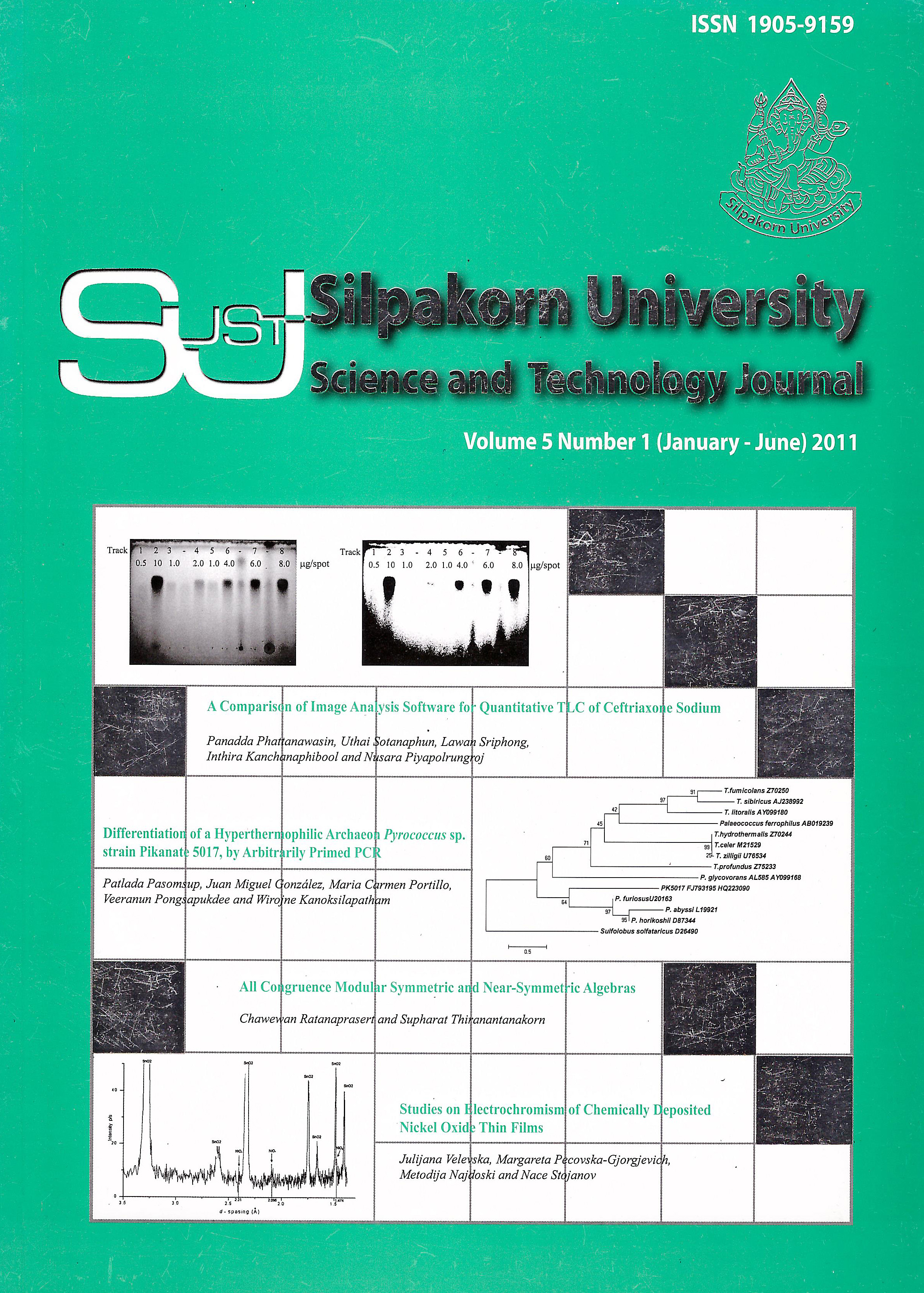Studies on Electrochromism of Chemically Deposited Nickel Oxide Thin Films
Main Article Content
Abstract
In this work, nickel oxide (NiOx) thin films were prepared from aqueous solution of nickel nitrateand carbamide. Those films were deposited onto fluorine doped tin oxide (FTO) coated glass substrates. Anelectrochromic test device (ECTD) was constructed by using these films as working electrodes, and FTOcoated glass as an opposite electrode in alkaline medium of 0.1 M NaOH aqueous solution. The obtainednickel oxide films exhibited anodic electrochromism, changing color from transparent to dark brown. Varioustechniques were used for characterization of the films as x-ray diffraction (XRD), visible spectroscopy andelectrochemical methods. The dependence of the optical density on the charge density was examined and thecoloration efficiency was calculated from the optical density change. The time response was also determined.
Downloads
Article Details
References
Arakaki, J., Reyes, R., Horn M., and Estrada, W. (1995). Electrochromism in NiOx and WOx obtained by spray pyrolysis. Solar Energy Materials and Solar Cells, 37: 33-41.
Cerc Korosec, R. and Bukovec, P. (2006). Sol-Gel Prepared NiO thin films for electrochromic applications. Acta Chimica Slovenica, 53: 136-147.
Cheng, J., Fan, D. B., Wang, H., Liu, B. W., Zhang, Y. C. and Yan, H. (2003). Chemical bath deposition of crystalline ZnS thin films. Semiconductor Science and Technology, 18: 676.
Cinnsealach, R., Boschloo, G., Nagaraja, S., and Fitzmaurice, D. (1998). Electrochromic windows based on viologen - modified nanostructured TiO2 films. Solar Energy Materials and Solar Cells, 55: 215-223.
Ezema, F. I., Ekwealor, A. B. C. and Osuji, R. U. (2008). Optical properties of chemical bath deposited nickel oxide (NiOx) thin films. Superficies Vacio, 21(1): 6-10.
Ferreira, F. F., Tabackniks, M. H.,. Fantini, M. C. A, Faria, I. C. and Gorenstein, A. (1996). Electrochromic nickel oxide thin films deposited under different sputtering conditions. Solid State Ionics, 86-88: 971.
Igwe, H. U., Ekpe, O. E, Ugwu, E. I. (2009). Effects of Thermal annealing on the optical properties of nickel oxide thin films prepared by chemical bath deposition technique. Pacific Journal of Science and Technology, 10(2): 806-810.
Jiao, Z., Wu, M., Qin, Z., and Xu, H. (2003). The electrochromic characteristics of sol-gel-prepared NiO thin film. Nanotechnology, 14: 458-461.
Kadam, L. D. and Patil, P. S. (2001). Studies on electrochromic properties of nickel oxide thin films prepared by spray pyrolysis technique. Solar Energy Materials and Solar Cells, 69: 361-369.
Kitao, M., Izawa, K., and Yamada, S. (1995). Electrochromic properties of nickel oxide films prepared by introduction of hydrogen into sputtering atmosphere. Solar Energy Materials and Solar Cells, 39: 115-122.
Lechner, R. and Thomas, L. K. (1998). All solid state electrochromic devices on glass and polymeric foils. Solar Energy Materials and Solar Cells, 54: 139-146.
Liu, X., Qiu, G., Wang, Z., and Li, X. (2005). Rationally synthetic strategy: from nickel hydroxide nanosheets to nickel oxide nanorolls. Nanotechnology, 16: 1400-1405.
Mane, R. S. and Lokhande, C. D. (2000). Chemical deposition method for metal chalcogenide thin films. Materials Chemistry and Physics, 65: 1-31.
Maruyama, T. and Arai, S. (1993). The electrochromic properties of nickel oxide thin films prepared by chemical vapor deposition. Solar Energy Materials and Solar Cells, 30: 257-262.
Nagai, J. (1993). Characterization of evaporated nickel oxide and its application to electrochromic glazing. Solar Energy Materials and Solar Cells, 31: 291-299.
Park, J. Y., Akn, K. S., Nah, Y. C., Shim, H. S., and Sung, Y. E. (2004). Electrochemical and electrochromic properties of Ni-oxide thin films prepared by a sol-gel method. Journal of Sol-Gel Science and Technology, 31: 323-328.
Ragan, D. D., Svedlindh, P., and Granqvist, C.G. (1998). Electrochromic Ni oxide films studied by magnetic measurements. Solar Energy Materials and Solar Cells, 54: 247-254.
Ristova, M., Velevska, J., and Ristov, M. (2002). Chemical bath deposition and electrochromic properties of NiOx films. Solar Energy Materials and Solar Cells, 71: 219-230.
Rubin, M., Wen, S. J., Richardson, T., Kerr, J., Von Rottkay, K., and Slock, J. (1998). Electrochromic lithium nickel oxide by pulsed laser deposition and sputtering. Solar Energy Materials and Solar Cells, 54: 59-66.
Sonavane, A. C., Inamdar, A. I., Shinde, P. S., Deshmukh, H. P., Patil, R. S., and Patil, P. S. (2010). Efficient electrochromic nickel oxide thin films by electrodeposition. Journal of Alloys and Compounds, 489(2): 667-673
Subramanian, B., Mohamed Ibrahim, M., Senthilkumar, V., Murali, K. R., Vidhya, V. S., Sanjeeviraja, C. and Jayachandran M. (2008). Optoelectronic and electrochemical properties of nickel oxide (NiO) films deposited by DC reactive magnetron sputtering. Physica B: Condensed Matter, 403 (21-22): 4104-4110
Surca, A., Orel, B., Pihlar, B., and Bukovec, P. (1996). Optical, spectroelectrochemical and structural properties of sol–gel derived Ni-oxide electrochromic film. Journal of Electroanalytical Chemisry, 408: 83-100.
Todorovski, T., Najdoski, M., and Velevska, J. (2006). Chemical deposition of molybdenum oxide thin fims from dimethyl sulfate bath. International Journal of Pure and Applied Chemistry, 1(4): 549-552.
Velevska, J. and Ristova, M. (2002). Electrochromic properties of NiOx prepared by low vacuum evaporation. Solar Energy Materials and Solar Cells, 73: 131-139.
Wang, X., Song, J., Gao, L., Jin, J., Zheng, H., and Zhang, Z. (2005). Optical and electrochemical properties of nanosized NiO via thermal decomposition of nickel oxalate nanofibres. Nanotechnology, 16: 37-39.
Yoshimura, M. (1998). Importance of soft processing fort advanced inorganic materials. Journal of Materials Research, 13: 796-802.


